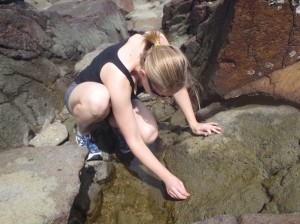by Katrina Lohan

Katrina Lohan scrapes mud and algae off a rock at Punta Culebra. Later, Lohan will use genetic tools to see what protozoan parasites are inside that sample.
(Kristina Hill)
I have realized that I am particularly interested in disease reservoirs. Unfortunately, this term is difficult to define. But basically, a disease reservoir can be anything (living or nonliving) where a disease-causing organism can survive outside of its host. As part of my fellowship project, I had already intended to use genetic tools to look for protozoan parasites in oysters and water samples. After further consideration, I have decided to also use genetic tools to look for parasites in other environmental reservoirs. It’s hard to predict what environmental reservoirs would be best to collect, so I was advised to choose a site, collect a few samples and just see what parasites are present. Then, I can use those results to help me decide how I should conduct a more extensive sampling scheme in the future.
With that in mind, Kristy and I headed to Punta Culebra to collect some reservoir samples. I was really excited, even though I wasn’t entirely sure how or what I was going to collect. But I was confident that I would know when I saw it. I decided to take three samples from five different sites along the rocks, roughly matching the sites where we had previously collected oysters. At low tide there are small tide pools within the rocks. I decided to collect from within these pools. In the end, I took three samples from each site. One was a sediment sample, which ranged from fine muddy sediments to larger coarse sediments with lots of shell bits. The second sample was from the living material that blanketed the rocks, which was probably a combination of mud, bacteria and turf algae. The third sample I took was a sample of a distinct clump of turf algae. I am really excited to see what protozoans I find!

